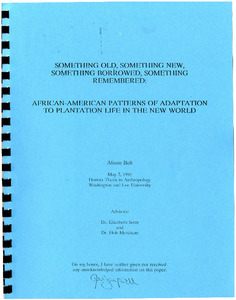| dc.rights.license | In Copyright | en_US |
| dc.creator | Bell, Alison Kay | |
| dc.date.accessioned | 2023-04-21T19:15:39Z | |
| dc.date.available | 2023-04-21T19:15:39Z | |
| dc.date.created | 1991 | |
| dc.identifier | WLURG038_Bell_thesis_1991 | |
| dc.identifier.uri | https://dspace.wlu.edu/handle/11021/36118 | |
| dc.description.abstract | The ultimate value of archaeology rests on the assumption that the material record is an inevitable reflection of past cultures' mental and spiritual lives. The material record should indicate the ways in which people responded to their environment. If not, archaeology is, as many have charged, just an expensive method of finding interesting objects. Much of the documentary evidence available on the non-material aspects of Afriecrn-Arnerican adaptation to plantation life demonstrates that the slaves' acculturation process was one of appropriating elements of Anglo-American culture into West African structures. Because the Africans' creolization was "material, psychological, crnd spiritual,'' there is no reason to assume that the pattern manifest in religion, language, music and oral tradition does not continue in the African-American material record. To understand how archaeologists might recognize this pattern in the distributions of artifacts on African-American sites, it is first necessary to synthesize the work of researchers who have identified such a process in African-American music, language, religion and oral tradition. Second, it is essential to consider ways in which this pattern is apparent in extant material culture, from basketry and agricultural technology to architecture. Finally, a review of the major archaeological reports on African-American sites is necessary to determine if the process of slaves transforming Anglo-American artifacts can be identified. [From Introduction] | en_US |
| dc.format.extent | 128 pages | en_US |
| dc.language.iso | en_US | en_US |
| dc.rights | This material is made available for use in research, teaching, and private study, pursuant to U.S. Copyright law. The user assumes full responsibility for any use of the materials, including but not limited to, infringement of copyright and publication rights of reproduced materials. Any materials used should be fully credited with the source. | en_US |
| dc.rights.uri | http://rightsstatements.org/vocab/InC/1.0/ | en_US |
| dc.subject.other | Washington and Lee University -- Honors in Anthropology | en_US |
| dc.title | Something Old, Something New, Something Borrowed, Something Remembered: African-American Patterns of Adaptation to Plantation Life in the New World | |
| dc.type | Text | en_US |
| dcterms.isPartOf | WLURG38 - Student Papers | |
| dc.rights.holder | Bell, Alison Kay | |
| dc.subject.fast | Plantation life | en_US |
| dc.subject.fast | Archaeology | en_US |
| dc.subject.fast | African Americans -- Race identity | en_US |
| dc.subject.fast | Creoles | en_US |
| local.department | Anthropology | en_US |
| local.scholarshiptype | Honors Thesis | en_US |
